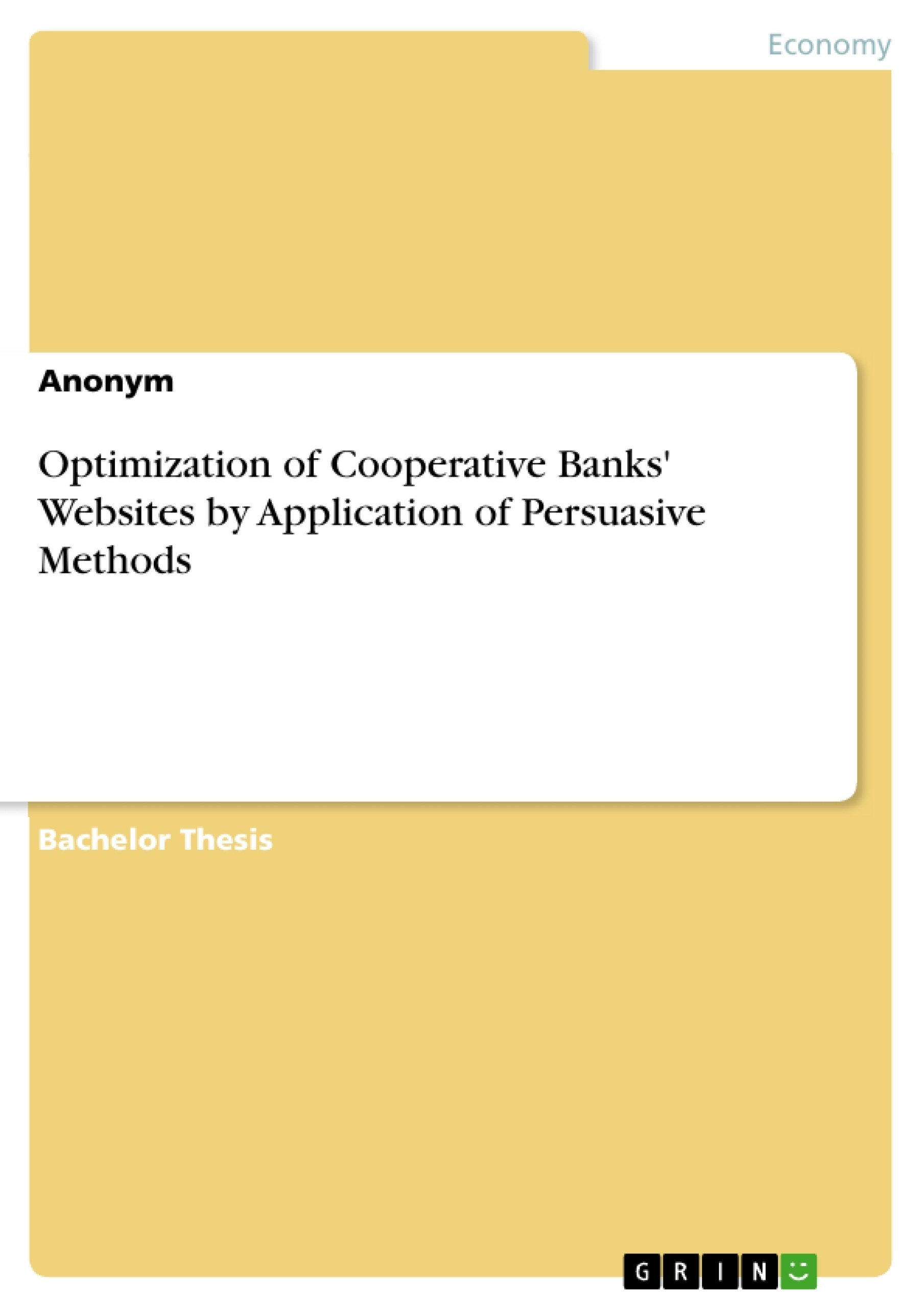
Optimization of Cooperative Banks' Websites by Application of Persuasive Methods
Bachelorarbeit, 2015
71 Seiten, Note: 2,3
Leseprobe
Inhaltsverzeichnis (Table of Contents)
- Introduction
- Starting Position
- Objective and Structure
- Cognitions of Neuromarketing
- Consciousness and Subconsciousness
- Pilot and Autopilot
- Framing Effect
- Priming Effect
- Emotions and Motives of Decisions and Buying Behavior
- Interaction of Emotion and Motive Systems: The Limbic® Map
- Neurobiological Target Group Segmentation: The LimbicⓇ Types
- Codes
- Language
- Storytelling
- Symbols
- Sensors
- Instruments of Persuasive Webdesign
- Persuasion and Mindset
- Rhetoric
- Ethos
- Pathos
- Logos
- Elaboration Likelihood Model
- Heuristic Systematic Model
- Decision Making Process
- Process Phases of the Buying Decision
- Influencing Factors of the Buying Decision
- Fogg's Behavior Model
- Extrinsic Motivation and Flow
- Persuasion by Triggers
- Similarity
- Selection
- Authority
- Scarcity
- Consistent Behavior
- Reciprocity
- Social Proof
- Applicability Analysis for Cooperative Banks
- Cooperative Principles and Values
- Website Objectives
- Online Design Guidelines for Volksbanken Raiffeisenbanken
- Application of Persuasive Webdesign Instruments
- Critical Assessment
- Conclusion
- Target Achievement
- Prospects
Zielsetzung und Themenschwerpunkte (Objectives and Key Themes)
This thesis aims to explore the optimization of cooperative banks' websites by applying persuasive design methods. It investigates how these methods can be used to improve user experience and generate competitive advantage in the banking sector. The study focuses on the specific example of Volksbanken Raiffeisenbanken, analyzing how persuasive design can be used to communicate their cooperative values and principles effectively online.
- The application of persuasive design principles in web design
- The role of neuromarketing and its impact on user behavior
- The importance of emotionalization and building trust in online banking
- The specific challenges and opportunities of applying persuasive design methods in the cooperative banking sector
- The potential for persuasive design to enhance customer engagement and loyalty
Zusammenfassung der Kapitel (Chapter Summaries)
The introduction provides a starting point for the study, outlining the increasing demands for effective website design and the importance of understanding user behavior patterns. It highlights the need for a user-centered approach that goes beyond simple usability and focuses on creating a motivating and engaging experience for users. The chapter also emphasizes the role of emotionalization in banking, particularly for cooperative banks, and introduces the specific example of Volksbanken Raiffeisenbanken.
Chapter 2 delves into the key concepts of neuromarketing, exploring the interplay of consciousness and subconsciousness, the influence of emotions and motives on decision-making, and the use of various codes to communicate effectively with users. It introduces the Limbic® Map as a tool for understanding emotional responses and identifies the LimbicⓇ Types as a framework for neurobiological target group segmentation.
Chapter 3 focuses on the instruments of persuasive web design, examining different approaches to persuasion, including rhetoric, the Elaboration Likelihood Model, and the Heuristic Systematic Model. It analyzes the decision-making process, highlighting the phases of the buying decision and the factors that influence it. The chapter then introduces Fogg's Behavior Model, a framework for understanding and influencing user behavior, and discusses the role of extrinsic motivation and flow in creating engaging experiences. It concludes by exploring persuasion by triggers, examining various techniques such as similarity, selection, authority, scarcity, consistent behavior, reciprocity, and social proof.
Chapter 4 applies the insights from previous chapters to the specific context of cooperative banks. It explores the cooperative principles and values, analyzes the objectives of cooperative banks' websites, and examines the online design guidelines for Volksbanken Raiffeisenbanken. It then delves into the application of persuasive web design instruments in this specific context, providing practical examples and insights. The chapter concludes with a critical assessment of the potential benefits and challenges of implementing persuasive design methods for cooperative banks.
Schlüsselwörter (Keywords)
Persuasive design, neuromarketing, user experience, cooperative banks, online banking, emotionalization, trust, website optimization, customer engagement, customer loyalty, Volksbanken Raiffeisenbanken, Limbic® Map, LimbicⓇ Types, Fogg's Behavior Model, triggers, rhetoric, decision-making process, online design guidelines.
Details
- Titel
- Optimization of Cooperative Banks' Websites by Application of Persuasive Methods
- Hochschule
- FOM Essen, Hochschule für Oekonomie & Management gemeinnützige GmbH, Hochschulleitung Essen früher Fachhochschule
- Note
- 2,3
- Autor
- Anonym (Autor:in)
- Erscheinungsjahr
- 2015
- Seiten
- 71
- Katalognummer
- V349772
- ISBN (eBook)
- 9783668369900
- ISBN (Buch)
- 9783668369917
- Dateigröße
- 1338 KB
- Sprache
- Englisch
- Schlagworte
- optimization cooperative banks websites application persuasive methods
- Produktsicherheit
- GRIN Publishing GmbH
- Preis (Ebook)
- US$ 31,99
- Preis (Book)
- US$ 45,99
- Arbeit zitieren
- Anonym (Autor:in), 2015, Optimization of Cooperative Banks' Websites by Application of Persuasive Methods, München, Page::Imprint:: GRINVerlagOHG, https://www.diplomarbeiten24.de/document/349772
- Autor werden
- Ihre Optionen
- Vertriebskanäle
- Premium Services
- Autorenprofil
- Textarten und Formate
- Services für Verlage, Hochschulen, Unternehmen

- © GRIN Publishing GmbH.
- Alle Inhalte urheberrechtlich geschützt. Kopieren und verbreiten untersagt.
- info@grin.com
- AGB
- Open Publishing
Der GRIN Verlag hat sich seit 1998 auf die Veröffentlichung akademischer eBooks und Bücher spezialisiert. Der GRIN Verlag steht damit als erstes Unternehmen für User Generated Quality Content. Die Verlagsseiten GRIN.com, Hausarbeiten.de und Diplomarbeiten24 bieten für Hochschullehrer, Absolventen und Studenten die ideale Plattform, wissenschaftliche Texte wie Hausarbeiten, Referate, Bachelorarbeiten, Masterarbeiten, Diplomarbeiten, Dissertationen und wissenschaftliche Aufsätze einem breiten Publikum zu präsentieren.
Kostenfreie Veröffentlichung: Hausarbeit, Bachelorarbeit, Diplomarbeit, Dissertation, Masterarbeit, Interpretation oder Referat jetzt veröffentlichen!
- GRIN Verlag GmbH
-
- Nymphenburger Str. 86
- 80636
- Munich, Deutschland
- +49 89-550559-0
- +49 89-550559-10
- info@grin.com
-









